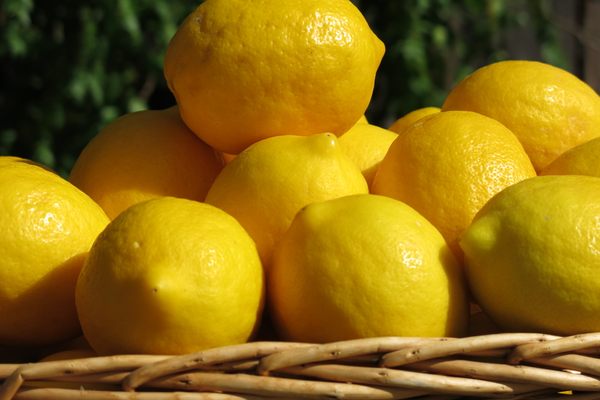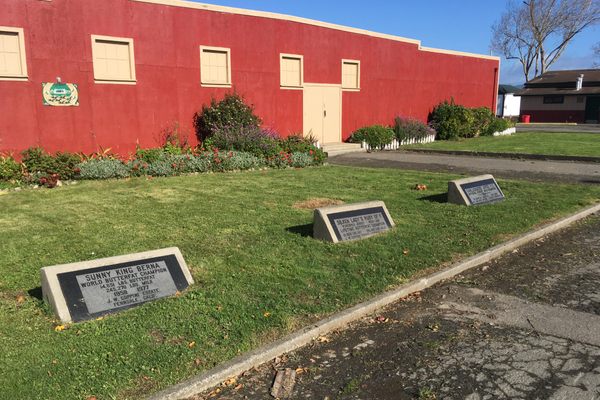How America’s Beloved Meyer Lemon Caused a Mid-Century Citrus Panic
The fragrant fruit hid a dark secret.
“To those who have never tasted them, our recurring insistence on Meyer lemons may seem like an irritating California eccentricity,” famed farm-to-table chef Alice Waters writes in her book Chez Panisse Fruit, “but I don’t know many people who have tried one without getting hooked.”
Indeed, Americans are hooked on this intensely fragrant golden citrus. The Meyer lemon blooms with bright floral and woody aromas, in place of one-note sourness. Because of its delicate rind, it is difficult to transport, so encounters with this mellow lemon, sweet enough to bite into without a grimace, are rare and precious.
But long before Martha Stewart proclaimed it the best citrus to grow at home and Waters began espousing its juicy attributes, the Meyer lemon threatened the citrus industry on the West Coast. Before it could topple citrus production on multiple continents, the U.S. government, scientists, and backyard gardeners united to combat the “Typhoid Mary” of the citrus industry.
The enigma of the Meyer lemon begins with its name. Unlike its grocery-store counterparts the Lisbon lemon and the Persian lime, the Meyer lemon doesn’t give credit to its motherland in its moniker. In fact, the Meyer is named USDA employee and “plant explorer” Frank N. Meyer, who introduced more than 2,500 new plant varieties to North America. Meyer is credited with bringing specimens of apricots and the wild pears stateside as well as introducing a hardy species of soybean that is still essential to American agriculture today. Yet only this lemon bears his name.

The title “plant explorer” evokes a dashing gent, brawny and tanned from traipsing international forests on a quest for unfamiliar specimens. Such a description suits Meyer, who trekked more than 10 miles each day on his missions across China, Russia, and Japan. But as he traveled, Meyer spent most of his time alone, viewed by the people of the countries he visited as a suspicious, out-of-place white man. He suffered from relentless bouts of depression and frequently wrote to his boss, the former plant explorer, David Fairchild, about his despair.
In a series of letters, Fairchild tried to cheer his employee by reminding him of the impact of his work on the American diet and the agricultural industry. In December 1917, Fairchild responded to Meyer’s concerns about a lack of new compelling discoveries by bringing up the lemon that would go on to be his namesake, “Why would not this be as interesting to many people as your Chinese lemon, which, by the way, is winning favor wherever it goes?”
Meyer had come across a dwarf lemon variety in the tiny village of Fengtai, near Peking (Beijing) China in the summer of 1908. The “Chinese” disappeared in references to the lemon around 1927, but Meyer wouldn’t live to see it. In his final letter to his boss in 1918, he describes soldiers holding him up while he attempted to mail pear seeds to the USDA. In a state of melancholy, Meyer boarded a boat on the Yangtze River. Just days later a boatman found his body floating in the river. The USDA archives state that Meyer’s death will “remain a mystery and source of speculation.”
The untimely demise of its namesake did not hinder the popularity of the Meyer lemon. In 1933, the Los Angeles Times lauded it as “a citrus fruit that should be widely planted in all California gardens.” And readers followed this advice. Soon, these fragrant and hardy fruit-bearing trees filled terraces, bloomed in backyard gardens, and added brightness to the dull concrete of parking-lot medians throughout the state.
A decade later, citrus growers and gardeners alike were shocked to see “Meyer Lemon Doomed Here” as the bold headline in California newspapers. Frank N. Meyer’s legacy fruit didn’t just bring golden, juicy sweet-tart flavors to the United States. It also brought over “quick decline citrus” virus, known in professional circles as citrus tristeza virus (CTV).

CTV works quickly. An orange or grapefruit tree may only show slight discoloration on the foliage, especially the veins of its leaves, before dying within days. Meyer lemon trees, however, could carry the virus and flourish for years without showing any symptoms.
As a result, it wasn’t immediately apparent upon the Meyer’s introduction to California gardens that it threatened the stability of the citrus industry. The pests who transmitted the disease, mostly aphids, only gradually carried the disease from sequestered home gardens to commercial citrus groves. Once scientists confirmed this transmission via aphid, Meyer lemon trees were “declared a menace” by the State Department of Agriculture in 1956. Plans to destroy the beloved ornamental plants were unrolled across the state, and warnings were sent to citrus growers as far away as Florida.
The urgent situation incited the first meeting of the International Organization of Citrus Virologists at the University of California, Riverside in 1957. This group of scientists and citrus growers urged drastic measures towards Meyer lemons the world over. “Tristeza exists in the Mediterranean area where it has been introduced on the Meyer lemon,” wrote one scientist in a paper he presented at the 1961 meeting of the IOCV. He goes on to suggest that it would be “most desirable” for all Meyer lemon trees “in the Mediterranean basin to be eradicated.”
As news of the troublesome Meyer trickled out of Riverside, the hunt began for the troublesome trees throughout the state. County after county passed bills aimed at uprooting the garden trees to stop tristeza. During the summer of June 1957, in the city of Selma, California, two government officials went door to door, telling residents to remove their Meyer lemons. Roughly 14 days later, they returned to ensure that the trees were gone. The fragrant magenta buds of the Meyer lemon plant were one of its most admired characteristics. Now, they served as a sign of a tree that needed to be destroyed.

The destruction of the Meyer lemon even took on a political meaning. One Republican Assemblyman, Patrick D. McGee, decried the efforts aimed at creating Meyer lemon-free zones in Sacramento county, calling it “one of the most dangerous bills” he’d ever read. The bill, he argued, allowed the California state director of agriculture “to go into your home or into any nursery in the state and order the destruction of the Meyer lemon trees.” He and other state politicians saw this as a threat to personal liberty.
Yet scientists and government officials with an interest in protecting the state’s vital citrus industry won out. As one orchard owner told The Chico Enterprise-Record in 1975, he was aware that the ongoing lemon massacre was going to “make people mad.” But he felt they would be less opposed to the idea when they realized how much tristeza could harm orchards across California.
However, people kept fostering illegal Meyer lemon plants, prompting the state to expedite efforts to develop a suitable substitute for the beloved tree. It proved to be a difficult balance to crossbreed citrus that was virus-resistant, but also offered gardeners the fragrant thin-skinned citrus they coveted.
Even at the accelerated pace it wasn’t until 1976 that the State finally endorsed an officially virus-free Meyer lemon plant, developed by the University of California at Riverside and grown by Hobbs Nursery in Visalia. Once again, Meyer lemon trees rolled out across the state, to decorative and culinary gardens, public and private. Eventually this “improved Meyer lemon” (the only kind of Meyer lemon you can purchase in the U.S. today) rolled in through the back door of Alice Waters’ kitchen at Chez Panisse in Berkeley.
The 1988 release of her cookbook with Paul Bertolli, Chez Panisse Cooking, took America by storm, more out of fascination than anything else. After all, how many home cooks had access to Meyer lemons, Seckel pears, or an oak fire for grilling veal chops in the 1980s? But, Chez Panisse added Meyer lemons to the mainstream American vocabulary. First, with a simple Meyer lemon cake, and then with Meyer lemon relishes and eclairs in subsequent books.

In 2003, Martha Stewart took up the Meyer mantle, proselytizing the good word of the fragrant Meyer lemon not only in her recipes but also her gardening tips. The trees had remained mostly confined to Florida, Texas, Arizona, and California before the release of the “improved” species of tree. But with Stewart’s loyal and widespread fanbase, they quickly became popular in markets around the country.
As the second wave of Meyer lemon mania began to crest, journalists still mentioned Frank N. Meyer’s name and the fruit’s Asian origins. But by the mid-aughts, many articles targeted towards home cooks credited Martha Stewart with bringing the adored fruit to the American kitchen, while texts written for professional chefs and hospitality workers mentioned Chez Panisse or Waters herself as the original advocate of the Meyer lemon.
With these two culinary powerhouses spreading the word of all things Meyer lemon, both Frank N. Meyer’s adventures and the menacing reality of CTV slipped from modern memory. Few now remember that California’s favorite fragrant lemons once hid a dark secret.
Gastro Obscura covers the world’s most wondrous food and drink.
Sign up for our email, delivered twice a week.




































Follow us on Twitter to get the latest on the world's hidden wonders.
Like us on Facebook to get the latest on the world's hidden wonders.
Follow us on Twitter Like us on Facebook